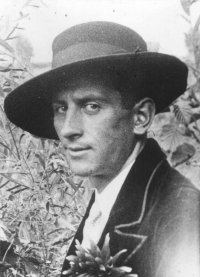
Vaclovas Ratas in 1934,
as a young 24-year-old artist.
as a young 24-year-old artist.
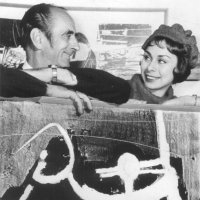
Vaclovas Ratas with daughter
Ramona in Sydney, 1964.
Ramona in Sydney, 1964.
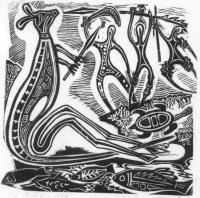
Vaclovas Ratas, The Hunt, 1952
(Perth) Wood engraving, 14.5 x 14cm
(Perth) Wood engraving, 14.5 x 14cm
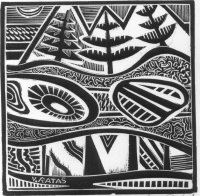
Vaclovas Ratas, The Trees, 1953
(Perth) Wood engraving, 14.5 x 14cm
(Perth) Wood engraving, 14.5 x 14cm
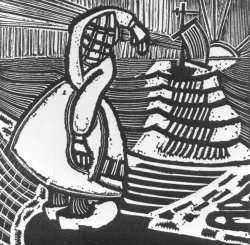
Vaclovas Ratas, Jurate and Kastytis (Mother)
1937 (Kaunas) Woodcut,10cm x 10cm
1937 (Kaunas) Woodcut,10cm x 10cm
Having shown exceptional talent for drawing from a young age, he enrolled in the Kaunas National Academy of Art, where he studied under the noted Professor Adomas Galdikas, from whom he acquired a broad outlook on art and skills of printmaking. Ratas graduated in 1935 and furthered his studies in Venice, Florence and Rome.
By 1933 Ratas had already made a name for himself in art circles having joined the groups "Art" and "Forma". After graduation he illustrated the book "Seku Seku Pasaką" and began participating in art exhibitions in Lithuania and beyond.
At the International Art Exhibition in Paris in 1937, Ratas was awarded the Prix d'Honeur for his woodcut illustrations of "Juratė and Kastytis", a ballad by the Lithuanian poet Maironis. The same year he took part in an international exhibition of lithographs and woodcuts in Chicago, USA. He achieved considerable recognition as one of the leading young graphic artists in Lithuania. His works were purchased by notable collectors and galleries in Europe and USA.
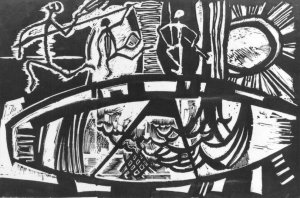
Vaclovas Ratas, Mimi, 1965 (Sydney)
Wood engraving, 12.5 x 18.5cm
Wood engraving, 12.5 x 18.5cm
He participated in the International Graphic Arts and Book Exhibition in Belgium, the Netherlands, Paris and Germany. Ratas took part in publishing 40 Woodcuts (1946), Lithuanian Art in Exile (1948) and his woodcuts illustrated the book The Twelve Ravens (1949).
In 1949, Ratas and his family migrated to Australia, first to Perth then in 1954 to Sydney. He worked as designer-model maker at Darbyshire Pottery in Perth and Diana Pottery in Sydney. He enjoyed the challenges of pottery, and he produced exciting new forms and metallic glazes not seen in Australia before. Roger Butler, in the book The Europeans (National Gallery of Australia), writes, "The speed with which the emigre artist embraced Aboriginal art is astounding. Vaclovas Ratas who landed in Perth in 1949 produced woodcuts that incorporated Aboriginal motifs by the end of that year".

Vaclovas Ratas, Emu, 1970 (Sydney)
Colour Monotype, 48 cm x 48cm
Colour Monotype, 48 cm x 48cm
As a result of that exhibition the Sydney Printmakers Society was formed, initially with 24 members. Yearly exhibitions were held at Blaxland Gallery at the Grace Bros store. These became an important event of the Sydney Art Calendar. Ratas' past curatorial experience proved invaluable in assembling and presenting the works to their greatest advantage in each exhibition. The Printmakers attracted growing interest from the public, art collectors and critics. The society's activities and its membership continued to grow over the years, and activities now include cultural exchange exhibitions overseas. The legacy Ratas left to Australia in forming the Sydney Printmakers Society may even have surpassed all his expectations.
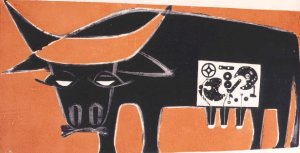
Vaclovas Ratas, Milk Factory, 1970 (Sydney)
Woodblock & metal collage print, 35 x 66.5cm
Woodblock & metal collage print, 35 x 66.5cm
Sadly, in 1966 Ratas was diagnosed with acute leukaemia and six months to live. His wife Regina, insisted he was not told of this "sentence". His daughter Ramona took leave of absence from touring with the Australian Ballet and took some of his work to America. There she mounted successful solo exhibitions on his behalf in New York, Chicago, Cleveland, Los Angeles and Boston.
In the seven years of life until his death, his style became colourful and joyful. He developed a unique monotype technique with his fantasy turning to nature, the sun, sea, birds. He died on January 3,1973, in Telopea, Sydney.
Vaclovas Ratas is remembered as an artist of diverse talents, who excelled in traditional methods, was able to grasp new concepts and who constantly experimented with new techniques. He was a quiet man, very determined in his aims. He did not waste words or actions on trivia, but lived purposefully, never accepting defeat. Ratas' work is represented at the National Gallery of Australia, Canberra, major Australian State Art Galleries, Lithuanian Art Museum, Vilnius and Kaunas, as well as internationally.
The legacy of this great man, Vaclovas Ratas, is woven into the artistic fabric of Australia.